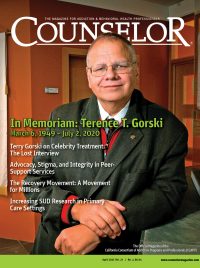Share
As I was training on motivational interviewing the other day via Zoom, I referenced relapse prevention in the context of the maintenance stage of change and had to pause for a moment. I was overcome with emotion as I remembered that my most revered and instrumental mentor had passed away. As I shared with the group what was happening for me, they graciously provided their condolences and then something remarkable happened: a few of the attendees reached for their Staying Sober: A Guide for Relapse Prevention (Gorski & Miller, 1986) books and their copies of The Staying Sober Workbook (Gorski, 1992) and held them up to their cameras to show me. Needless to say, that did nothing to dry out my tear-filled eyes! What a testimony to the mark Terence Gorski made on our profession!
When I was asked to write a memorial tribute in his honor, my first reaction was one of hesitation, as I could not possibly write something that would do him justice. However, I quickly changed my stance when I thought about the effect his work has had on my personal recovery and the light it has held for my career path in many ways. Therefore, I am honored to share with you my brief encounters with the man and acknowledge some of the work that has left such an impression on how we treat addiction today.
My first introduction to Terence T. Gorski’s work was in January 1989, when I was about ninety days sober and fresh out of an inpatient treatment program. I came across his article in the Sober Times magazine entitled “Cocaine Craving and Relapse” (Gorski, 1989). I benefited from this article as much as any information I received while in treatment. The insight and knowledge I gained has compelled me to pass it on to patients, students, and colleagues ever since. As an aside, a couple of decades later I filmed a talk based on the same information which has become my best-selling rehab video. The information is as relevant today as it was when he first went public with it in the late 1980s.
In the fall of 1999, I had the honor of meeting Gorski when he spoke at the California Association of Alcoholism and Drug Abuse Counselors (CAADAC) annual conference. I was awed to hear this recovery icon speak in person. I shook his hand at the end of the talk and shared with him the effect his work had on my recovery and career.
Later that night, I was headed for my hotel room across the street and there he came, walking down the street! Once again, I extended my hand to him and elaborated on the influence his work had on me. I spoke about my relapse prevention lecture series, which is largely based on his work from a decade prior, and he appeared genuinely thrilled that someone was using the information in that way. The next thing we knew, an hour and a half had passed as we spoke at that Sacramento intersection until around 11:00 PM. The genuine interest he exhibited in me and my work, and the time he took at that hour to visit with this “wet behind the ears” counselor, left a lasting impression regarding who this man was.
A few years later, when the program where I was working hired him to do an all-day talk on relapse prevention, I was tasked as his escort. I got to pick him up at his hotel, take him to the event, then drive him to the Ontario airport, allowing me even more time with him. This visit was also significant for me personally, as it was during the drive to Ontario that I told him I was writing a book and that one of the chapters would be dedicated to the CENAPS Model of Relapse Prevention Therapy (CMRPT). With all the courage I could muster, I asked if he would be willing to write the foreword for me. Much to my delight and surprise he graciously agreed, and the book was published in 2005.
I would now like to acknowledge some of the innovations Gorski developed that left such an imprint on our profession. I want to preface this by acknowledging that his accomplishments and contributions are so large, I could not possibly do them justice here. However, I would like to point out what I consider to be highlights of his revolutionary work, specifically regarding relapse prevention.
Prior to Gorski’s work, relapse was typically seen as an event. He introduced the idea that relapse is actually a process that culminates in the actual use. Further, he identified thirty-seven relapse warning signs—“sign posts” if you will—that can signal for recovering people that they are on the road to relapse before they actually drink or use (Gorski, 1986).
He further developed this warning-sign identification process by introducing the idea that for each of these warning signs there are associated thoughts, feelings, urges, actions, and reactions (TFUARs) that serve as additional markers in the relapse process and that can be identified and intervened upon. It is this work that eventually became the cornerstone of the curriculum for his Relapse Prevention Therapy–Advanced Certification course.
Another gift to our profession was Gorski’s identification of “the craving cycle,” consisting of obsession, compulsion, physical craving, and drug-seeking behavior (Gorski, 1989). This was monumental because it provided counselors with a guide of the precursors to the craving cycle (i.e., setup behaviors and trigger events) instead of merely providing tools of recovery. By focusing on such precursors, individuals can avoid getting to the craving cycle in the first place, or at least minimize how often it occurs, which provides a much greater defense against relapse.
Regarding the aforementioned trigger events, another innovation was his use of Pavlovian or classical conditioning to explain how an event becomes a trigger. Further, by identifying the science behind triggers, he was able to also identify what he called the “trigger recovery process”:
- Avoidance
- Gradual reintroduction
- Extinction
Prior to this information, we only addressed triggers by teaching our clients to identify and avoid them—which is often difficult in our society—rather than to actually recover from them (Gorski, 1989).
Finally, Gorski coined the well-known term “post-acute withdrawal syndrome” (PAWS; Gorski, 1986). The importance of this identification of withdrawal symptoms that occur after the visible “shake and bake” detoxification cannot be underestimated. People in early recovery who are experiencing PAWS symptoms such as insomnia, the inability to concentrate, memory problems, and anhedonia (i.e., the inability to experience pleasure) might say something like, “If this is what sobriety is going to be like, I don’t want any part of it.” With the identification of this syndrome, treatment professionals can let their patients know that the condition is temporary and that things will get better over time. This is invaluable information for people struggling with PAWS in early recovery.
There is really so much more to acknowledge about this recovery pioneer. Many of Gorski’s numerous publications have helped so many of us to be the best counselors we can be, including Denial Management (Gorski & Grinstead, 2001) and Post-Incarceration Syndrome (PICS) (Gorski, 2010), the latter of which addresses issues caused by long prison sentences and the challenges of assimilating back into the community—Shawshank Redemption is no joke! I hope I have used this space efficiently to pay tribute to perhaps the most instrumental innovator and trainer regarding addiction recovery our profession has ever known.
On behalf of those who have benefited from your work, and those who will benefit in the future, we thank you, Terry!
References
- Gorski, T. T. (1989). Cocaine craving and relapse. Sober Times, 3(4), 6, 29.
- Gorski, T. T. (1992). The staying sober workbook: A serious solution for the problem of relapse. Independence, MO: Herald House.
- Gorski, T. T., & Grinstead, S. (2001). Denial management counseling professional guide: Advanced clinical skills for motivating substance abusers to recover. Independence, MO: Herald House.
- Gorski, T. T., & Miller, M. (1986). Staying sober: A guide for relapse prevention. Independence, MO: Herald House.
- Gorski, T. T. (2010). Post incarceration syndrome (PICS) and relapse. Retrieved from http://facebook.com/GorskiRecovery/posts/1867228366642992

Bob Tyler
Bob Tyler, BA, LAADC, CADC-II, has been working in inpatient, residential, and intensive outpatient levels of care since 1990. He serves as compliance officer at LA CADA, is owner of Bob Tyler Recovery Services (consulting, CD private practice, training), is past president of CAADAC, and is on faculty at LMU Extension in the AOD Studies Program. He authored the EVVY Award-winning book, Enough Already! A Guide to Recovery from Alcohol and Drug Addiction, and has produced several educational DVDs shown in over one thousand treatment centers across the country, including Craving and Relapse.












 Counselor Magazine is the official publication of the California Association of Addiction Programs and Professionals (CCAPP). Counselor offers online continuing education, article archives, subscription deals, and article submission guidelines. It has been serving the addiction field for more than thirty years.
Counselor Magazine is the official publication of the California Association of Addiction Programs and Professionals (CCAPP). Counselor offers online continuing education, article archives, subscription deals, and article submission guidelines. It has been serving the addiction field for more than thirty years.